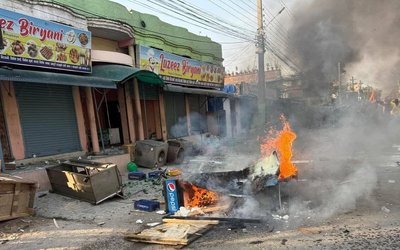More on News





At a time when many government agencies failed to spend the development expenditure received under a foreign aid, the Rural Access Improvement and Decentralization Project (RAIDP) has posted a hundred percent progress. The man behind this success is project coordinator ASHOK KUMAR JHA. In that context, Jha spoke to NEW SPOTLIGHT on various issues. Excerpts:
How is your experience with RAIDP?
My experience is that successful mobilization of the communities and local bodies can make a lot of difference in development projects. RAIDP has shown that the bottom up approach is more successful than the present top down approach in implementing the road and infrastructure projects.
What is RAIDP?
RAIDP is a project for rural road upgrading and construction under the Ministry of Local Development and DOLIDAR. This is one of the key projects of DOLiDAR operating in 30 districts of Nepal with financial assistance from the World Bank. We construct roads and other infrastructure as per the demand of the local communities. RAIDP has nothing to do with selection of the projects as it is the duty of the District Development Committee, Village Development Committee and local community to take decisions on any infrastructure. With their planning, RAIDP supports the projects. DDC will look after whether the roads fulfill the requirements of the district or not.
How do you view the role of the communities?
Communities too need to make certain contributions. For instance, the local communities must agree to hand over the land to the project voluntarily. We rarely enter in compensation schemes. If we start the construction of rural roads under compensation scheme of the government, we cannot construct them. Nepal’s rural network is so long that it is beyond the capacity. We have 47,000 kilometers of rural roads. Out of them, only 20 percent is serviceable, because of low standards of the roads. Our aim is to make them operational with the support from the government. Our compensation act is so lengthy and complicated that it is virtually impossible. We also look at social screening, and environmental screening. Only after justification by these two factors, we will implement the projects.
Is RAIDP related to rural road construction only?
RAIDP is not only upgrading and constructing roads but also attempting to enhance good governance at the local level through various practical activities. In addition to this, the project also educates concerned stakeholders about various technical, environmental and social issues and helps the local authorities address all types of issues relating to subprojects for promoting effective, transparent and participatory governance. Unlike other projects, this project is based on bottom up approach. The focal point of implementation is the District Development Committee and technical side managed by the District Technical Office DTO.
What is the total cost of the project?
The total cost of the project is 98 million US dollars. Out of it, IDA is financing 32+45 million US dollars with 35 million USD disbursement and 33.4 million US dollar reimbursement. The project started in August 2005 and will end by December 31, 2013.
What is the major objective of the project?
The project development objective is for resident of participating districts of the recipients to utilize improved rural transport infrastructure and services in order to have enhanced access to social service and economic opportunities. At the end, the project aims to upgrade and rehabilitate existing 1165 kilometers roads and to construct 211 kilometers of dry season roads in hill districts. The project also aims to construct 350 trail bridges and 10 motorable river crossings.
How do you assess your success?
After the utilization and improvement of rural transport, 37 percent increase in motorized and 33 percent in motorized trips compared to 2005 and 2012. Similarly, travel time reduced from 2.5 hours to average 1 hour i.e. 60 percent reduction in travel time. There is an increase of 97 percent motorized traffic and 76 percent non-motorized traffic. More than 95 percent of the rural population under the project areas live within four hours of walking to an all-season road. We have already upgraded 1165 kilometer road to all season standard by January 2012. Similarly, we have already upgraded 211 kilometer road to dry season standard. We achieved the target three years before the completion of the project. I can say that I will be completing more than the target set for the project with less money.
How can you complete 1600 kilometers of roads by the budget allocated for 1135 kilometers?
Because of our e-bidding system, there is no carteling, no collusion and no intimidation among the bidders. The bidders are working by reducing 30 percent of the allocated budget.
Along with road construction, the project records all types of adverse social and environmental impacts and mitigates them. The progress made in the technical, environmental and social issues are highly successful.
At a time when Ministry of Finance said that concerned ministries failed to use the resources coming as a grant, how have you been able to spend the budget allocated to the project?
This is the project which is widely popular in rural parts of Nepal and there is a wide demand for it. Another reason is that this is very transparent and based on a governance risk assessment of the rural road sector which was undertaken within the framework of on-going RAIDP in order to identify the strengths of the existing governance framework and major governance failures, issues and possible risks that the project should address to ensure the successful accomplishment of its development objective.
There are various organizations working in the road sector. Don’t you think there are lapses in the work?
There are now only two road networks: the strategic road network and rural road network. SRN is under the Ministry of Physical Planning and Rural Road Network is under the Ministry of Local Development. Highway, feeder road and Hulaki Rajmarg are regarded as strategic road networks and remaining rural road networks are under the MoLD.





